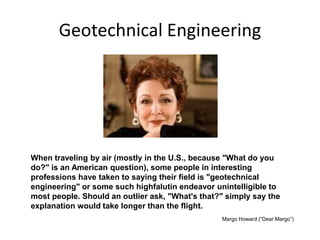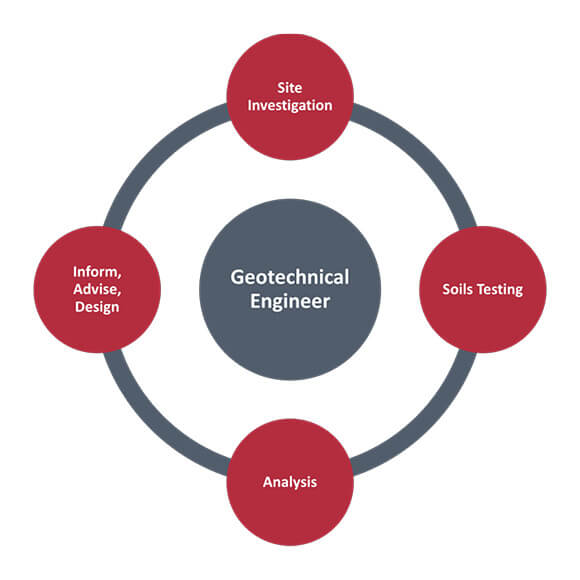Things about Geotheta
Things about Geotheta
Blog Article
The Buzz on Geotheta
Table of ContentsGeotheta for DummiesEverything about GeothetaNot known Details About Geotheta Geotheta Things To Know Before You Get ThisSome Known Questions About Geotheta.

They perform site examinations, collect samples, execute laboratory examinations, and assess data to assess the suitability of the ground for building and construction projects - Geotechnical Engineers. Based on their searchings for, geotechnical designers give suggestions for foundation design, slope stability, retaining structures, and mitigation of geotechnical dangers. They collaborate with other experts, such as engineers, structural engineers, and construction teams, to make sure that geotechnical considerations are integrated into the overall project style and application
By analyzing the actions and properties of soil and rock, they can determine prospective geotechnical threats such as landslides, dirt negotiation, or incline instability. Their know-how aids prevent failings or crashes that might threaten lives and residential or commercial property. Below are some in-depth obligations and duties of a geotechnical designer: Site Investigation: Geotechnical engineers conduct site examinations to gather data on subsurface problems.
They interpret the information to comprehend the properties and behavior of the soil and rock, including their strength, permeability, compaction qualities, and groundwater conditions. Geotechnical Analysis and Design: Geotechnical designers evaluate the information accumulated during site investigations to assess the security and suitability of the site for building jobs. They do geotechnical computations and modeling to examine aspects such as bearing ability, negotiation, incline stability, lateral planet stress, and groundwater circulation.
Geotheta Fundamentals Explained
Foundation Layout: Geotechnical designers play a vital role in making structures that can safely support the desired structure. They assess the soil problems and lots requirements to determine the ideal structure type, such as superficial foundations (e.g., grounds), deep structures (e.g (https://realistic-swam-lvtf1k.mystrikingly.com/blog/unlocking-the-secrets-of-geotechnical-engineers-the-geotheta-advantage)., heaps), or specialized strategies like soil improvement. They consider aspects such as negotiation limitations, bearing capability, and soil-structure communication to establish optimum structure styles
They assess building plans, screen website tasks, and carry out field inspections to verify that the layout referrals are adhered to. If unforeseen geotechnical problems emerge, they analyze the circumstance and offer recommendations for remediation or adjustments to the layout. Threat Assessment and Reduction: Geotechnical engineers analyze geotechnical dangers and risks related to the project website, such as landslides, liquefaction, or soil disintegration.

Cooperation and Interaction: Geotechnical engineers work very closely with other professionals involved in a task, such as designers, architectural engineers, and building teams. Efficient communication and collaboration are necessary to integrate geotechnical factors to consider into the total project style and construction process. Geotechnical engineers give technical know-how, response queries, and ensure that geotechnical demands are met.
The Ultimate Guide To Geotheta
Here are some types of geotechnical designers: Foundation Designer: Structure designers concentrate on designing and examining foundations for frameworks. They examine the dirt conditions, tons requirements, and site attributes to determine the most proper foundation type and style, such as superficial structures, deep foundations, or specialized methods like heap structures.
They examine the variables affecting slope stability, such as soil properties, groundwater conditions, and slope geometry, and establish strategies to stop slope failures and reduce dangers. Earthquake Engineer: Earthquake designers focus on evaluating and making structures to endure seismic forces. They examine the seismic hazard of a website, evaluate dirt liquefaction potential, and create seismic layout standards to make sure the safety and security and durability of structures throughout quakes.
They do field testing, collect examples, and assess the gathered information to define the soil buildings, geologic developments, and groundwater conditions at a website. Geotechnical Instrumentation Designer: Geotechnical instrumentation designers concentrate on surveillance and gauging the behavior of soil, rock, and structures. They mount and preserve instrumentation systems that keep an eye on elements such as soil settlement, groundwater levels, slope movements, and structural variations to examine efficiency and give early cautions of potential concerns.
About Geotheta
They perform tests such as triaxial examinations, consolidation tests, straight shear examinations, and permeability examinations to gather data for geotechnical analysis and layout. Geosynthetics Engineer: Geosynthetics designers specialize in the layout and application of geosynthetic products, such as geotextiles, geogrids, and geomembranes. They make use of these materials to enhance dirt security, strengthen inclines, provide drain solutions, and control erosion.
They often tend to be investigatory people, which means they're intellectual, introspective, and inquisitive. They wonder, systematic, sensible, analytical, and logical. Some of them are likewise social, suggesting they're kind, charitable, cooperative, client, caring, helpful, understanding, skillful, and pleasant. Does this seem like you? Take our totally free career test to learn if geotechnical designer is among your top occupation matches.
In the workplace setting, geotechnical engineers make use of specialized software program devices to execute computations, develop styles, and analyze information. They prepare reports, review project specifications, connect with clients and team participants, and coordinate task activities. The office setting gives a favorable setting for study, analysis, and collaboration with various other experts involved in the project.
Our Geotheta Ideas
They often check out project websites to perform website investigations, evaluate geotechnical problems, and gather information for evaluation. These visits entail traveling to different places, often in remote or challenging surfaces. Geotechnical designers may execute dirt sampling, conduct examinations, and monitor building and click this site construction activities to make certain that the geotechnical facets of the project are being executed appropriately.
Geotechnical designers also work in specialized geotechnical labs. Geotechnical research laboratory engineers work extensively in these environments, managing testing devices, operating instruments, and taping data.
Report this page